How to make a Radiator Reflector
Have you considered that your radiators pump 50% of the output into the wall that they are hanging on? It seems such a waste that your heating system is working that hard to heat your walls. Installing a foil radiator reflector can dramatically reduce heat loss through your walls and increase the comfort in your home.
If you’re looking to cut down on costs of running your home but don’t want to make sacrifices in comfort, then insulating behind your radiators can be a quick, cost effective way of reducing heating bills whilst maintaining warmth.
We have put this blog together to answer some of the most common questions we get asked about insulating behind radiators.
Some of the most frequently asked questions we get asked about using our insulation in radiators.
- Why should I insulate my radiators?
- Should I insulate all my radiators?
- Can I use tinfoil?
- Do radiator reflectors work?
- Should I make my own radiator reflectors?
- What is the best insulation for radiators?
- How do I make radiator reflectors?
Why should I insulate my radiators?
Insulating a radiator may seem like a strange concept, however our radiators don’t just radiate heat internally, so any heat on the wall side can be lost through the wall and out of your home. In fact, 50% of the heat emitted from a radiator is direct at the wall and approximately 25% of it is lost through the wall!
Heat will always travel from a warm place to a cold so installing a reflective foil insulation behind your radiators will result in more heat being reflected into the room instead of being lost through the wall. Tests have shown an increase in the temperature output of over 5 degrees C, approx. 1 foot away from the radiator after a radiator shield has been installed.
Should I insulate all my radiators?
Which radiators you insulate depends on your home and the rooms you really want to keep most comfortable. Generally, all exterior walls would be insulated as these are the most likely to draw heat from inside for it to be lost externally. Internal walls really depend on how often certain rooms are used. If, for example you have a radiator on a wall between two bedrooms, both of which are slept in, then heat passed through the wall wouldn’t be considered ‘lost’. However, if you had a radiator on a wall between two bedrooms and the other was a spare room or guest room that is rarely used then it may be worth insulating the radiator to limit heat loss.
The same goes for party walls, if you know your neighbours are heating their homes too then you may have less need to insulate those radiators however the room on the opposite side of a party wall may not be used often and not heated. It might be worth asking your neighbours about their rooms that join yours and whether they heat them regularly.
Can I use tinfoil?
It is always best to use an insulation material that will provide a thermal break (has a core). You can read more about different types of foil insulation here.
I have seen a few people online that have tried using tinfoil. There are a few issues with using tinfoil beginning with the difficulty involved in getting such material behind the radiators. Tinfoil isn’t rigid enough to slide easily behind any radiators so you would need to remove them from the wall to get tinfoil installed. Also, tinfoil creases very easily and it looks terrible. So if the radiator is in an area where it is seen you want something more aesthetically pleasing.
Do radiator reflectors work?
Yes, they work very efficiently. Fitting a radiator reflector will reflect all that heat back into your room.
Radiator reflectors will also reduce the energy needed to heat your home. Case studies have shown that a three-bedroom house with 5 external wall radiators can show more than 20% improvement in radiator efficiency by using radiator reflectors and save as much as £10 per square metre! So, this is a quick fix for reducing costs at home, but it also creates a noticeable increase in warmth and comfort for the occupants.
How do radiator reflectors work?
- Heat Reflection: A radiator directs a substantial portion of its heat at the wall, not the room it aims to heat. If there’s no reflective surface behind the radiator, especially near an external wall, the wall absorbs some heat and loses it outside, particularly if the wall lacks good insulation. Placing reflective foil insulation behind the radiator reflects this radiated heat into the room, enhancing the radiator’s efficiency in heating the space.
- Conductive Loss Reduction: The wall also conducts heat, leading to losses. Placing a reflective foil barrier behind the radiator reduces this heat conduction, ensuring the room retains more heat.
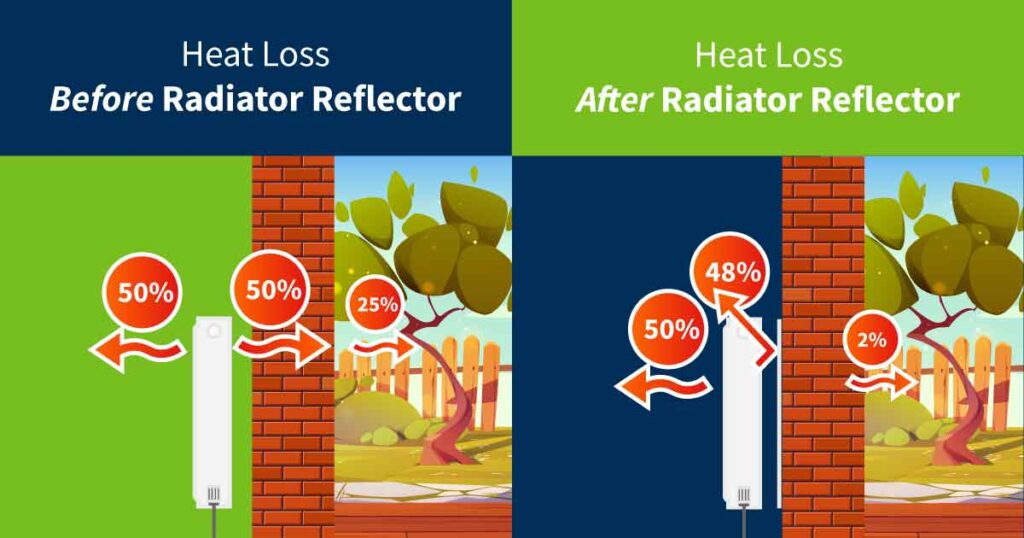 (image) How radiator reflectors work and how heat can be lost through a wall.
(image) How radiator reflectors work and how heat can be lost through a wall.
How much energy do radiator reflectors save?
It’s difficult to calculate the exact savings you’re set to receive by installing a radiator reflector as several factors influence the amount of heat lost through a wall, such as:
- Wall insulation (type and thickness)
- Wall material (type and thickness)
- Wall quality (construction and condition)
- Radiator location
- Temperature difference
- Door and windows present in the wall
- Reflective shield material (design and quality)
Considering that, here is a generic attempt to demonstrate how much energy can be saved in a practical situation.
Without a Reflective Shield:
Energy Loss: Radiators fixed against uninsulated walls might see 20-30% of their heat being lost to the wall. Let’s take an average and assume 25% heat loss.
Usage Pattern: If the radiator operates at 1 kW (an arbitrary figure for this calculation) and runs 6 hours daily, it uses 6 kWh/day. Over 30 days (one month), it would use 180 kWh. Out of this, 25% or 45 kWh would be lost to the wall.
With a Reflective Shield:
Energy Savings: A reflective shield can save a significant proportion of the heat that would otherwise be lost. It might reflect back 80-95% of the heat the wall would have absorbed. For this example, let’s be conservative and assume a reflection rate of 85%.
Reflected Energy: 85% of the 45 kWh lost to the wall would be 38.25 kWh.
Net Energy Lost: Without a shield, you lost 45 kWh. With a shield, you only lose about 6.75 kWh (45 kWh – 38.25 kWh).
Estimated Savings:
Over a month, the savings would be approximately 38.25 kWh.
So, this is a quick fix for reducing costs at home, but it also creates a noticeable increase in warmth and comfort for the occupants.
Should I make my own radiator reflectors?
There are a few companies online selling radiator reflectors, some of which sell multi-packs of three or five etc to insulate a few of your rads. The issue with some of these is that they are standard size and not fit for your specific radiators, therefore they may have large areas exposed or may be too small. Also, the materials used for these can be very cheap and mostly ineffective. Many are made of cheap bubble wrap and/or mylar which is a foil coated plastic. You can learn more about Mylar here.
DIY radiator insulation is a great option as you can make bespoke reflectors that perfectly fit your rads and making them couldn’t be simpler! Getting hold of a good quality reflective insulation is really all you need as many of these can be cut with scissors or a sharp blade, so no specialty tools are required.
What is the best insulation for radiators?
As we have discussed already, reflective foil insulations are used for making radiator reflectors and these are readily available from plenty of places online. However, not all foil insulations are created equal so be sure to opt for a high-quality brand (Such as Low-E Insulation) that will be effective and will last! Most importantly, make sure to look for a material made with aluminium, not mylar as I mentioned above.
I chose to use Low-E Reflective Insulation as they make their products with pure aluminium that reflects 97% of radiant heat, exactly what I need for this project. Their 5mm foil insulation is also Class 1 fire rated and made from recycled material which was important to me when I was shopping around. I knew I wanted something that would be fine to be exposed to heat for prolonged periods without any negative effects.
How do I make radiator reflectors?
DIY radiator insulation is simple! No special tools are required and the Low-E Insulation that I used made no mess at all. You can use a measuring tape to measure your rads and cut the reflectors however I just held the insulation up against each radiator and marked the height and width on the foil.

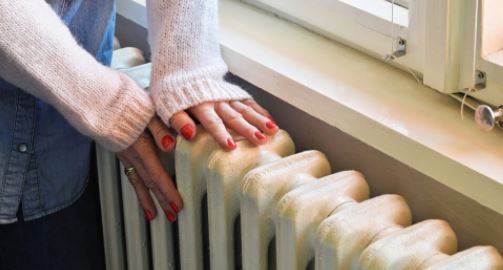
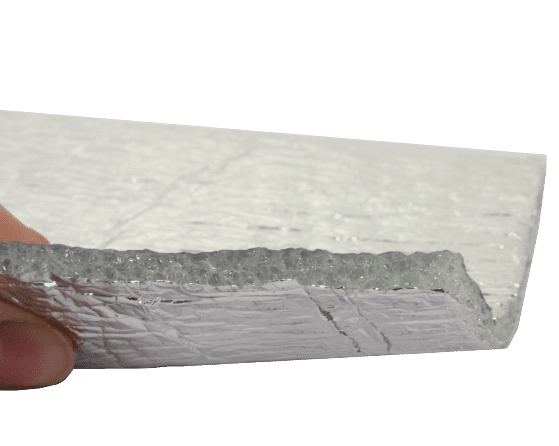
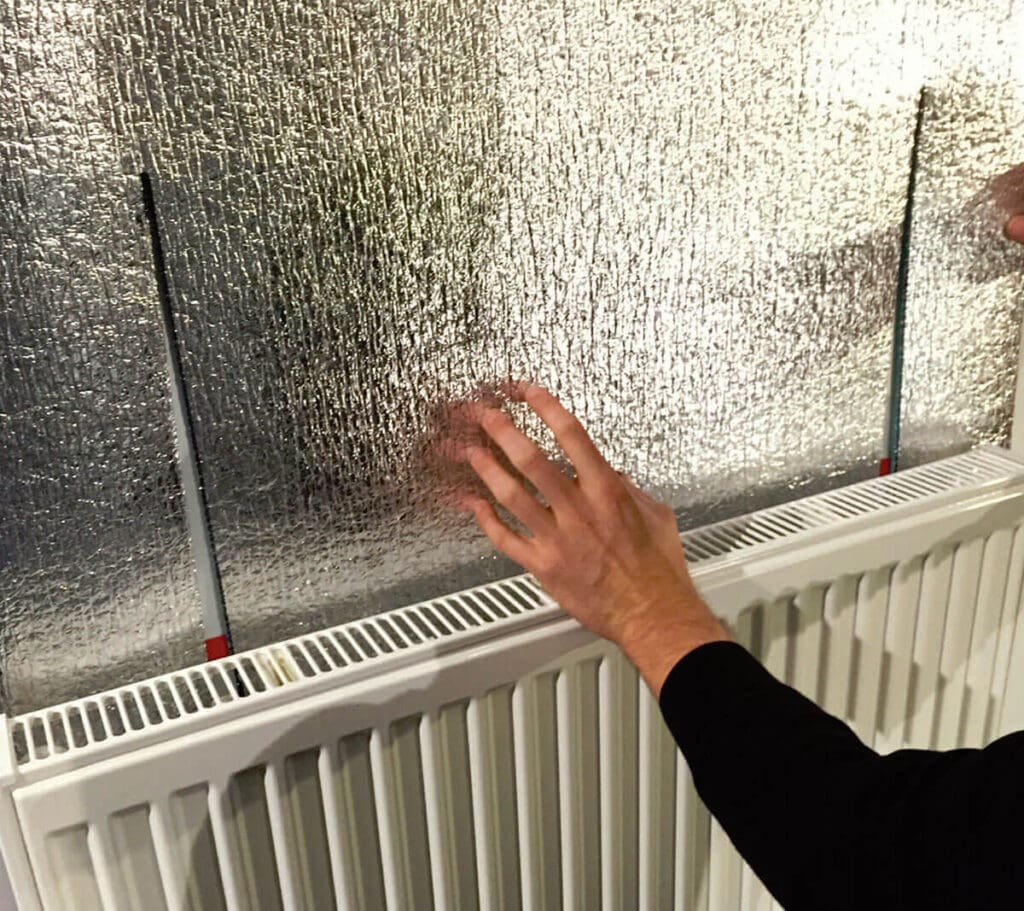

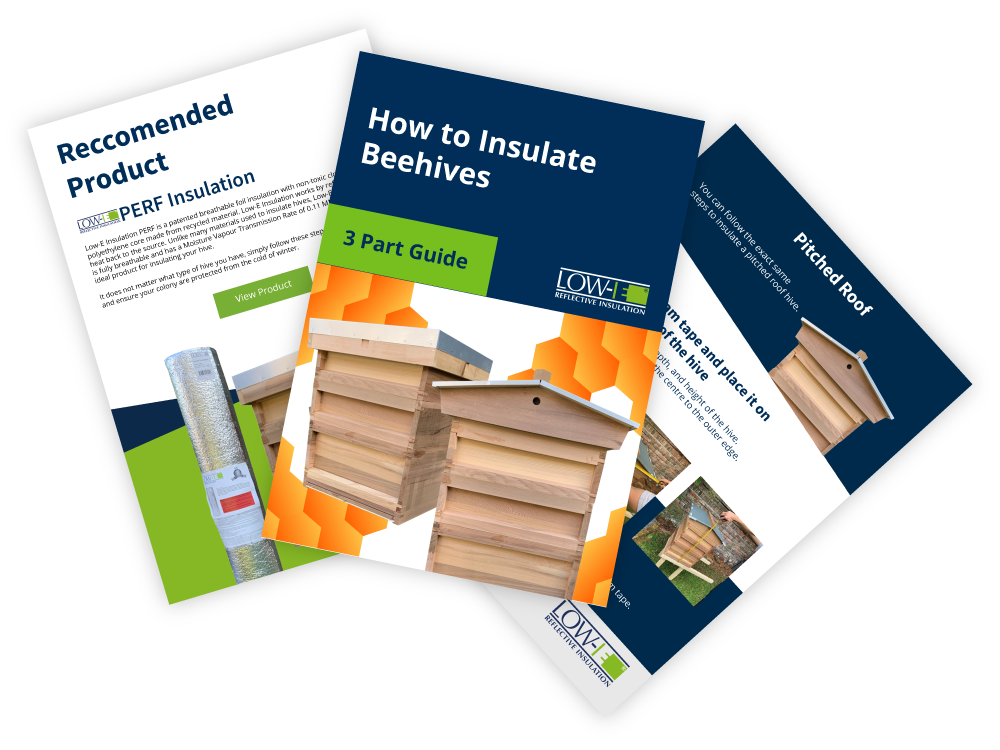
Recent Comments